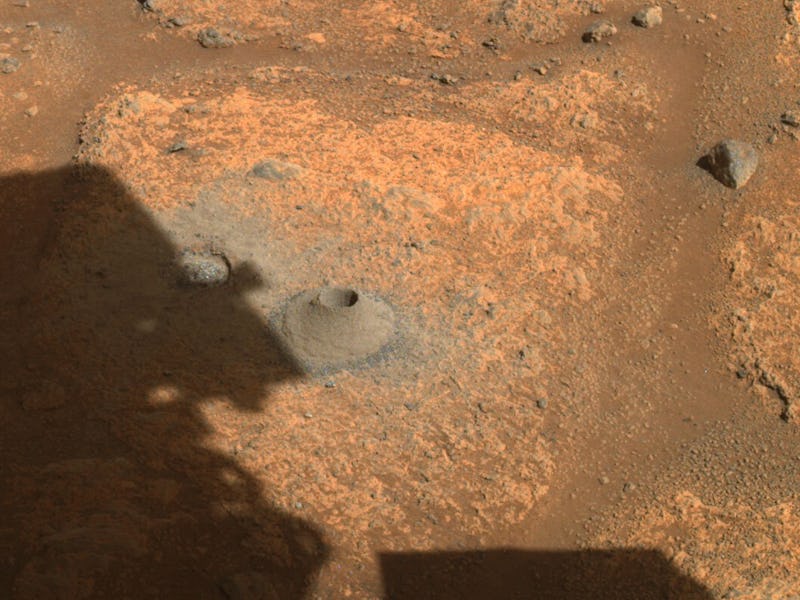NASA Perseverance rover: The hunt for life on Mars falters
The first sample collection attempt turned up emtpy.

It’s been 167 sols (or Martian days) since NASA’s Perseverance rover has been on Mars, and the car-sized robot has recently gotten to work hunting for signs of ancient life on another planet.
But Perseverance’s first attempt at collecting samples from the Red Planet turned up empty, and the team behind the mission is currently trying to figure out what went wrong before attempt number two.
Perseverance landed on Mars on February 18 with an unprecedented task of collecting samples from the Martian landscape, storing them in tiny tubes, and leaving them on Mars for a future pickup mission. This will eventually allow scientists to analyze direct Martian samples inside a lab for the first time.
Perseverance got to work earlier this month, but the Mastcam-Z instrument showed the sample tube inside the coring bit and it appeared empty.
How does the sample collection work? Perseverance is supposed to collect at least 20 samples from Mars using a drill attached to the robot's arm,
The samples move through the robot's belly and into the Adaptive Caching Assembly System, where they are assessed and processed. The assembly system contains seven motors and more than 3,000 parts, including the Sample Handling Arm used by the rover to hold sample tubes.
But on its first try, the robot sort of fumbled the collection part.
"The sampling process is autonomous from beginning to end," Jessica Samuels, the surface mission manager for Perseverance at NASA's Jet Propulsion Laboratory in Southern California, said in a statement. "One of the steps that occurs after placing a probe into the collection tube is to measure the volume of the sample. The probe did not encounter the expected resistance that would be there if a sample were inside the tube."
Perseverance is carrying 43 titanium sample tubes. After its first attempt at collecting samples from Mars, data sent back to Earth the rover showed that the sample tube was empty.
This image was taken by the rover on August 6 and shows that there is in fact no rock or dirt inside sample collection tube No. 233.
"While this is not the 'hole-in-one' we hoped for, there is always risk with breaking new ground," Thomas Zurbuchen, associate administrator of NASA’s Science Mission Directorate in Washington, said in a statement. "I'm confident we have the right team working this, and we will persevere toward a solution to ensure future success."
Right now, the Perseverance mission is assembling a response team to analyze the data.
Firstly, they will use the WATSON (Wide Angle Topographic Sensor for Operations and eNgineering), a color camera located at the end of the robotic arm, to take close-up pictures of the empty tube.
After they’ve figured out what went wrong the first time, they will be able to schedule Perseverance’s next attempt at sample collection.
"The initial thinking is that the empty tube is more likely a result of the rock target not reacting the way we expected during coring, and less likely a hardware issue with the Sampling and Caching System," Jennifer Trosper, project manager for Perseverance at NASA’s Jet Propulsion Laboratory, said in a statement. "Over the next few days, the team will be spending more time analyzing the data we have, and also acquiring some additional diagnostic data to support understanding the root cause for the empty tube."
This isn’t the first time the Martian landscape has gotten the best of a NASA rover’s equipment.
A drill attached to the Curiosity rover’s mechanical arm broke down in 2016, preventing Perseverance’s predecessor from analyzing samples of Mars’ ancient rocks.
It took around 15 months for the drill to be back in action.
About the Perseverance mission
Perseverance will look for signs of habitability on the Martian surface and past microbial life, collecting samples of rocks and soil and setting them aside for a future mission to return them to Earth.
The mission will also test out conditions for possible human exploration of Mars by trialing a method of producing oxygen from the Martian atmosphere, characterizing environmental conditions such as water and dust on Mars, and looking for resources.
Perseverance rover is set to spend at least one Martian year on the planet — the equivalent of 687 days on Earth.
This article was originally published on